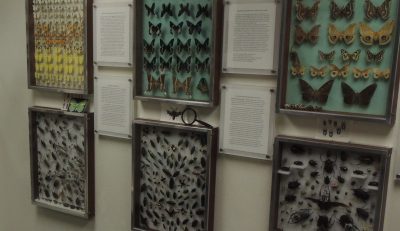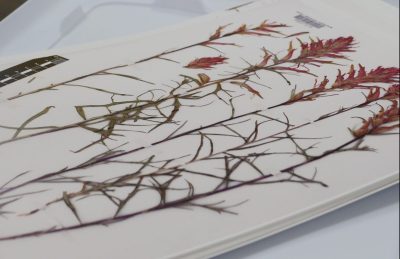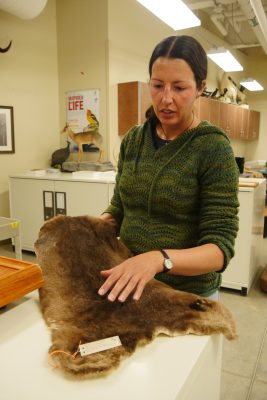The University of Wyoming College of Agriculture, Life Sciences and Natural Resources hosts three museums of natural history: the Insect Museum, the Rocky Mountain Herbarium, and the Museum of Vertebrates.
Read on to learn about the unique collections and histories of each of these museums.
These articles were originally published in the 2024 issue of Reflections, the annual research magazine published by the UW College of Agriculture, Life Sciences and Natural Resources.
Small Bugs Add Up to Big Discoveries
The fourth floor of the agriculture building may seem an unlikely place to find one of UW’s most unusual museums. Yet that’s where you’ll find the UW Insect Gallery. The gallery displays tableaus of specimens, facts, and even live insects.

Scott Shaw, professor of entomology and curator of the UW Insect Museum, began setting up the public gallery soon after arriving at the university in 1989. Its opening in 1993 celebrated 100 years of entomological studies at UW; in October 2023, several new exhibits were added to mark its 30th anniversary.
At first glance, the museum’s behind-the-scenes research collections may seem less interesting than the gallery. The cramped rooms are filled with towering museum cabinets and lined with books and other accoutrements of the insect-collecting trade.
Despite the small space, the collection contains more than a million preserved specimens from around the world, including over 500 type specimens — the first examples ever found of newly discovered species.
The insect collection got its start in 1892 with zoology professor Frank Niswander, but has grown exponentially over the last 130 years, supported in part by several National Science Foundation grants.
Entomologists of past centuries tended to collect museum specimens by venturing out with a net, favoring large species, but newer passive methods allow present-day entomologists like Shaw to discover tiny new species. These novel methods include flight-intercept traps, which are large mesh tents that funnel flying insects into jars filled with ethanol, instantly preserving them.
“A lot of other collections may be physically bigger or older, but we’ve been concentrating on really small things to increase the likelihood we’ll archive species that aren’t well represented,” explains Shaw.
In particular, Shaw studies parasitic Aleiodes wasps, tiny beneficial insects that lay their eggs inside caterpillars. The UW Insect Museum also boasts an impressive collection of robber flies and grasshoppers, as well as neotropical species.
In the Insect Gallery, you can find display cases filled with big, charismatic bugs, like butterflies, cicadas, and colorful beetles. Though Shaw’s microscopic wasps may not be as pretty, they’re a good reminder that even the tiniest creatures are worth understanding and preserving.
“We’re a long, long way from knowing everything there is to discover about insects, and even Wyoming species,” says Shaw. But one has to imagine that more than 500 new species and more than a million specimens have made a bit of a dent.
Pressed Plants Preserve History
With more than 1.4 million specimens, the Rocky Mountain Herbarium (RMH) is one of UW’s most impressive museum collections. About 900,000 of the herbarium’s specimens are cataloged online through a public database portal, and over 400,000 also have images available online.

Herbaria are plant museums. Botanists press and preserve whole plants, then record data about who collected the sample, where and when it was found, elevation and site description, and other identifying information.
Though all museums catalog history, the Rocky Mountain Herbarium’s history permeates every aspect of the Aven Nelson building. The structure was named after botanist Aven Nelson, who founded the herbarium in 1894. Today, the herbarium is poised to take over the Aven Nelson building’s second floor.
The herbarium needs the space. Many of the RMH’s samples have been lurking on top of museum cabinets for years, unprotected and difficult to access.
A recent National Science Foundation grant has helped fund the efforts to expand the museum’s footprint and digitize images of samples along the way. “As we move specimens as part of the expansion process, we’re capturing images. That not only protects them, it increases accessibility by getting them out of cardboard boxes and into both our physical and digital collections to use,” says David Tank, the herbarium’s current director. “That’s a big job.”
“Big” is perhaps an understatement. The RMH has a history of active, focused collection efforts. Under the leadership of former director Ron Hartman, students in UW’s floristics program would collect hundreds of samples a day throughout each summer.
This history of fieldwork allows current students a unique opportunity: the chance to go out and re-survey areas that were first surveyed decades ago and see what’s changed. For example, thanks to the work of past floristics students, botanists have an excellent snapshot of just when invasive species first showed up in Wyoming. This wealth of historical data also gives them tools to make data-informed hypotheses about what might shift going forward as new species show up and ecosystems change. RMH’s collections help not only to preserve species diversity in the present, but are also invaluable in perpetuity.
All museums are an investment from the past in an unpredictable future. Tank and other botanists remain dedicated to protecting and expanding the rich legacy of the Rocky Mountain Herbarium for years to come.
To read an article about the herbarium’s unique history and outreach efforts, visit Rocky Mountain Herbarium Curates a Century of Access and Conservation.
UW Vertebrate Museum Salvages and Safeguards Wyoming’s Unique Creatures
The University of Wyoming Museum of Vertebrates is exactly what it sounds like: a museum dedicated to preserving vertebrate species. Other collections on UW’s Laramie campus, like the Geological Museum and the Anthropology Museum, also include some vertebrate samples, but their focus is on ancient history, rather than modern morphology or recently extinct species.

There are three kinds of collections in the vertebrate museum: dry collections, tissue samples (often organs) that are stored cryogenically, and wet collections. The dry collection contains preserved mammals and birds, skeletons, skins, nests, eggs, and scat. The wet collection includes whole reptiles, amphibians, fish, parasites, or parts of animals stored in ethanol. In total, the museum hosts about 22,000 specimens from 865 different species.
Though it may sound grim, these collections serve an important function. “We don’t understand what we’re doing to this world,” says Beth Wommack, staff curator and collections manager of the UW Museum of Vertebrates. “Understanding how animals are reacting to the changes in the environment will help us mitigate our effects.”
Wommack’s goal is not just to expand databases, but also to treat animals with respect by carefully preserving and displaying them. By preserving vertebrate specimens, animals are remembered again and again — not just when they first perish, but whenever someone accesses that specimen, for as long as the collection lasts.
“A lot of research is interested in asking a specific question, you take measurements and then go away — but with a vertebrate museum, that animal isn’t just there for that one question, it’s there to understand that species, that habitat, that time period, for any question someone has in the future,” says Wommack.
UW’s vertebrate museum recently became part of the Ranges Project, an effort funded by the National Science Foundation that brings together vertebrate museum specimens from across North America and Mexico. The grant focuses on digitizing data on mammal specimens. This information, also known as attribute data, could include an animal’s body size or where it was found.
“We’re probably the smallest collection in the Ranges Project,” admits Wommack.
But the UW Museum of Vertebrates’ roughly 7,600 mammals fill an important gap. Wyoming is a unique environment, from the species that call it home to its physical and social landscapes.
As curator of the vertebrate museum, Wommack has forged personal relationships with salvagers, hunters, and the Wyoming Game and Fish Department — relationships that likely wouldn’t exist outside of Wyoming.
The UW Museum of Vertebrates plans to help preserve that unique environment for quite some time. Since 2011, the museum has been housed in the Berry Biodiversity Conservation Center. Faculty curator Matt Carling helped design the museum with extra cabinets and room to grow into the new space.
Though the vertebrate museum may not have collections as extensive as other museums on campus, it is already used by researchers, elementary school students, community members, and even art or history students who may look at the specimens from another perspective. UW’s vertebrate museum will remain a place where Wyoming communities can learn from all of Wyoming’s exceptional creatures.
To read an article about the vertebrate museum’s connection with art, visit UW Museum of Vertebrates Supports Scientific Outreach and Education through Art.




